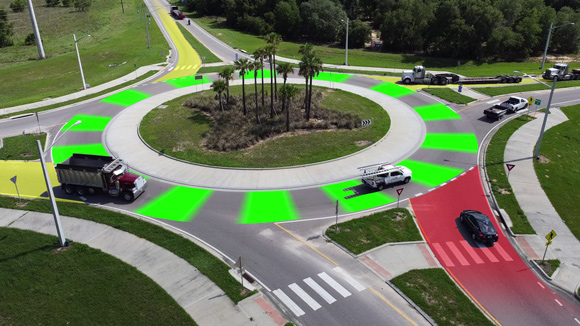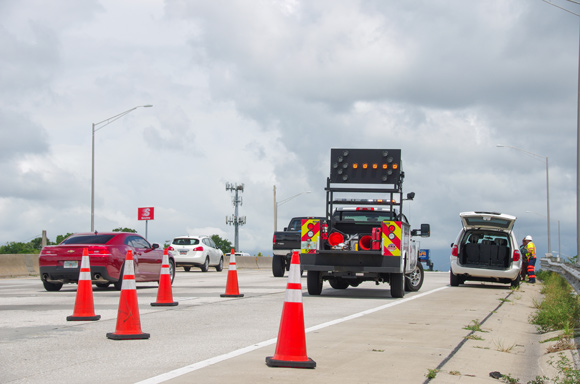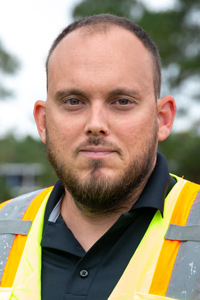New Drivers Learn to Navigate Innovative Intersections

|
| Click image above to watch video |
| |
Roundabouts, diverging diamond interchanges (DDI), and other innovative intersections are becoming popular throughout Florida and the U.S. They are designed to increase safety and shorten travel times for both drivers and pedestrians.
While some beginning drivers may already know a little about roundabouts and DDIs, many still have misconceptions about how these designs actually work. “New drivers need to understand how to properly enter and exit these new interchanges,” said Florida Highway Patrol’s Lieutenant Kim Montes.
For example, unless they have learned the correct way to use roundabouts, new drivers may assume they have the right of way when entering one. But Montes warns that drivers must yield to all vehicles and pedestrians before entering the intersections.
“New drivers need to learn from day one how to properly navigate these interchanges to avoid crashes,” Montes said.
In fact, beginning drivers often adapt to the new configurations more easily than veteran drivers who have not yet experienced roundabouts or DDIs.
“Since newer drivers are still developing their foundation, adding to it comes naturally,” said Kayla King, a licensed driving instructor for 2Cool Traffic School. “When they learn about new interchanges and road rules, it’s just another thing that they learn as they become a safe driver.”
Misunderstandings are of course not limited to beginning drivers. Experienced drivers also may make mistakes because they are so accustomed to traveling through more traditional types of intersections. “After all,” King said, “they have already completed the part of their life where they learned how to drive.”
That can create issues when parents who are not familiar with the interchanges teach their children to drive. “The challenge is… we rely on parents to teach new drivers when they themselves may not understand these interchanges,” Montes said. But, hopefully, young drivers who learn the proper way to navigate the interchanges will share their knowledge with family members.
Educating drivers about roundabouts and DDIs can help make everyone safer on the road ahead. “It’s important to introduce drivers to the many different types of intersections that they could encounter while they are still developing their foundation,” King said.
To learn more about roundabouts and DDIs, check out these toolkits of educational materials at I4Beyond.com/roundabout and I4Beyond.com/DDI.
Traffic schools and driver’s education programs should feel free to incorporate these materials into their curriculum and share them with beginning drivers.

|
| Click image above to watch video |
|
|
National Traffic Incident Response Awareness Week Encourages Safe Driving
All motorists rely on first responders to manage traffic incidents after they occur. But, those driving by don’t always think about the dangers first responders face each day.
It’s the firefighters, police, emergency medical crews, Road Rangers, hazmat teams, commercial tow truck drivers, and others who assist injured victims, direct vehicles past the site, untangle traffic tie-ups, clear the wreckage, mop up fuel spills, and manage the scene so that secondary crashes do not occur.
As other cars and trucks roll past, the men and women assisting with the aftermath of a crash must depend on careful drivers for their own safety.
This year, organizers of National Traffic Incident Response Awareness Week are sharing this urgent message with the slogan: “Slow Down. Move Over. Be Safe.”
During the week of November 9–15, the group will highlight the need for drivers to stay alert. They also are asking motorists to drive carefully in appreciation for the work of first responders and those who died on the roads in the line of duty.
In the very stressful and often confusing moments that follow a crash, everyone is encouraged to use caution. When drivers don't pay attention to the road or when they drive aggressively, first responders’ lives are put at risk. Last year, 44 crash-site responders died nationally while trying to help motorists and/or manage incident sites, according to the Emergency Responder Safety Institute. Another 39 have died so far this year, as of mid-October. Many more have been badly injured.
The national Traffic Incident Management (TIM) Network is sponsoring and promoting the recognition week by offering educational materials and videos with titles such as “Leave Your Phone Alone” and “It's No Picnic Out Here.”
To learn more about the extensive efforts of the Florida Department of Transportation’s Traffic Incident Management Network, please visit:
|
|
Construction Spotlight: Charles Long
Project Administrator for Construction, Engineering, and Inspection
on Wrong-Way Driving Detection Project
While growing up, Charles Long always had a knack for science and math.
But it wasn’t the schoolbooks he studied that opened his eyes to a future career. It was the visits he made to his grandfather’s office as a kid that captured his imagination and put him on a path toward engineering.
Today, he helps oversee the installation of wrong-way driving detection devices on Interstate 4 (I-4) ramps in Central Florida.
Yet Long might not even be in the field helping to direct such crucial safety projects if he hadn’t watched his grandad run a busy engineering office in Miami. There was something about his administrative style that left a deep impression. “It was his management of the office,” Long said. “He would be helping people, doing mathematical computations, and drafting plans. And he always had a general calmness.”
His grandfather — Luther Long — was a longtime engineer for the City of Miami and eventually assistant director of public works. “He didn’t give me career advice. He didn’t push us,” Long said. Nonetheless, he affected the young man’s life through the ease he displayed while handling multiple issues under pressure.
Long grew up in Kendall in South Florida and later moved to the Orlando area, where he attended the University of Central Florida. At first, he thought about studying biochemistry and medicine. But working in a lab made him realize he preferred managing people, building projects, and creating structures that serve the public. Just as his granddad had.
After switching fields, he earned an engineering degree from UCF with a focus on engineering construction management. He enjoyed it so much that he even began working nights on Florida Department of Transportation (FDOT) road projects to help earn his way through school.
After graduation, Long worked for FDOT for more than a decade, helping to manage numerous road and bridge building projects. About two years ago, he went to work for Cardno, a large engineering services company, as area manager for Central Florida.
While working on FDOT’s wrong-way driving project, Long likes the challenge of assisting in a wide range of tasks, including quality control, supporting workers, keeping the project on schedule, and dealing with the public. “I like to see a project through from start to end,” he said. Another lesson learned long ago.
Outside of work, Long likes spending time with his wife and their son and daughter. He enjoys driving his children to after-school activities and watching them participate in sports.
|
|
|






